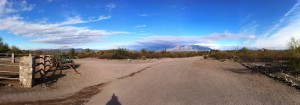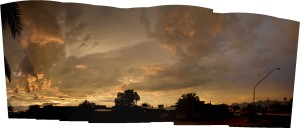Viewing the world in widescreen: My Panoramic Philosophy
CLICK PHOTOS TO ENLARGE
We don’t see the world in convenient little boxes.
Our view is wider and taller than that.
For a long time now I’ve been frustrated by what can fit in the photographic frame. It seems arbitrary and closed.
It’s a particularly futile medium for capturing the landscapes and atmospheres of the American west where I live, and the desert lands around Tucson in particular.
A few years back I started working with an app for the iPhone called Pano, which allows one to break the horizon into consecutive photographic slices and then combine them. The user interface was fairly simple and easy to use. And the results were quite good.
The problem was that in bright sunlight it was difficult to align the edges with the next frame, and even more so when the features on the horizon were less than graphically distinct. As a result one ended up with ghosting or doubled features in the pan.
And, of course, there wasn’t a lot of detail, owing to the limitations of the phone camera. It’s quite good for a phone camera, but no match for an SLR.
I recalled mention in a Photoshop tutorial of a technique where one might electronically stitch together consecutive photos to create large panoramas. I put it off for a long time, in part because I didn’t know where to look it up and partly because I imagined it was going to be complex. But eventually curiosity got the best of me.
As it turns out, it was far easier than I thought, though it puts a powerful mathematical strain on a computer and requires a fast unit to get the job done. Those first tests from mid-June 2012 were inspiring.
 For one, there was so much more detail, and the image size was enormous. You could just keep blowing it up and up and up and see more and more contained in the photo. If printed full size, some of these could be 3 feet x 36 feet. Pretty impressive.
For one, there was so much more detail, and the image size was enormous. You could just keep blowing it up and up and up and see more and more contained in the photo. If printed full size, some of these could be 3 feet x 36 feet. Pretty impressive.
For another, just the wide view of landscape and sky was so much more satisfying than the usual single-frame photo.
In this early phase I’ve just been going out and shooting with not a lot of control – just instinctively grabbing what the horizon has to offer. I haven’t used a tripod to unify the shots along a single plane. And I haven’t quite worked out the proportions of the horizon that yields best results yet. But in this phase of experimentation I am learning a great deal and seeing much greater potential than I had initially imagined.
And even as I grapple with the amorphous shapes this wild-eyed shooting is producing I’m envisioning extending the concept to different subject matter. Architecture on streets, nudes and still life art. Nudes in the landscape, or in controlled studio spaces. Even fashion or portrait photography as panoramic landscape.
![]() The next phase, which will begin in earnest following the premiere of my El Casino Ballroom documentary in August, will be to experiment with the use of a tripod in conjunction with the technique, and the experiment with nudes and cityscapes.
The next phase, which will begin in earnest following the premiere of my El Casino Ballroom documentary in August, will be to experiment with the use of a tripod in conjunction with the technique, and the experiment with nudes and cityscapes.
There’s also a lot of research to be done on the various methods within Photoshop to stitch the frames together as well, along with the use of masks to even out the light as one moves from looking into the sun to seeing the portion of the landscape illuminated by it.
Over the next several years I will be developing these techniques in conjunction with both my commercial and art projects.
– Daniel Buckley, 07/12/12





